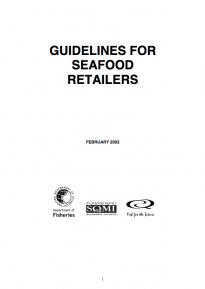Markets for Fresh Fish Retail
An important incentive for retailers to reduce food loss and waste (FLW) is to be able to offer and quickly sell fresh fish for a profit. In this respect, any packaging must be cost effective and products must meet the expectations of the consumer.
Small independent retailers specialize in selling fish and fish products. Being able to market and sell to consumers to avoid delays and storage time is important in preventing FLW.
Expansion of large supermarket chains which demand high standard handling and hygiene create a market driven demand for improved standards and practices at the production and processing stages, including certification by national standards and food safety authorities as well as the introduction of improved technology for fish storage and display. Market driven standards encourage retailers including independent fishmongers and their suppliers to put into practice procedures and processes which promote FLW control. An example of such standards is the British Retail Consortium (BRC) Global Standards.
Findings from a study of the UK retail sector found that FLW is more likely associated with fresh and chilled products. That species with high volume of sales will give rise to lower waste levels and that lower volume or higher value products may be associated with higher waste levels.
A Review of the Small Fish Retail Sector in the UK
A Review of the Small Fish Retail Sector in the UK
Key findings from a review of the UK small fish retailer sector that will be of interest to similar businesses which would like to improve efficiency were:
- Independent retailers need to use their expertise to encourage customers, old and new, to shop more frequently.
- The range on offer in the shop is very important as it may persuade customers to use an independent outlet.
- Shop environment is also crucial as consumers are increasingly aware of hygiene.
- Other routes to market are under-exploited by some retailers (e.g. supplying restaurant trade, delivery service, call and collect).
- Complementary items can be used to increase consumer spend.
- Generating new business and price occupy retailers’ thoughts. These are things that the independent retailers can influence.
- Independent retailers have an opportunity to make themselves more accessible by considering flexing their opening hours.
- Accessibility could also be improved by considering a delivery or call and collect service.
- Consumers are likely to be less price conscious when shopping in independent retailers.
Fish Counter Display and Merchandizing
Fish Counter Display and Merchandizing
A successful retailing business requires that a distinct and consistent image be created in the customer’s mind that permeates all product and service offerings. Visual merchandising can help create that positive customer image that leads to successful sales. It not only communicates the store’s image, but also reinforces the stores advertising efforts and encourages impulse buying by the customer. Visual merchandising is a major factor often over-looked in the success or failure of a retail store. It is second only to effective customer relations.
The importance of seafood display and presentation cannot be over-emphasized. The display will lure the customer to the shop and an interesting presentation will get the sale, particularly the impulse sale.
Seafood presentation, and the image of the premises and staff all have an impact on customers. Things to bear in mind during the presentation and display of seafood are:
- staff product knowledge (know about today’s product)
- the presentation should promote product freshness
- the premises should be clean and hygienic
- staff should be neat (e.g. uniforms) and hygienic
- display cabinets should be kept full
- good housekeeping
- effective lighting
- use plenty of ice
- use garnishes (e.g. whole or fruit slices, well washed parsley)
- location of product information
Good Practice for Retail Staff
Good Practice for Retail Staff
As well as quality, display presentation and price, the interaction between the retailer and consumer is also important, particularly where fish is sold by a fish monger or retailer direct to the consumer.
Staff appearance and manner have a marked effect on customer perceptions. Positive memories are what motivate customers to return. Knowledge of the product, personal appearance and the ability to engage in a friendly way with consumers are skills which will help the transaction process.
The objective of good service is to excite, incite and delight the customer. Good customer service may include such things as:
- smart appearance
- speed of service
- knowledgeable and experienced staff
- polite and personal attitude
- building a relationship with your customer (building loyalty)
Avoid over-promising and under-delivering as customers seek service not apologies.
Influencing How Customers Buy
Influencing How Customers Buy
Food retailers have the knowledge and means to influence how consumers buy, cook and even store and dispose of fish at home. Ideas include:
- Understanding why some of products are being thrown away by consumers
- Reducing the cognitive distance between the production and consumption of food products by proactively informing consumers how these products came to be
- Making information about products easy to understand
- Applying information technologies to help consumers quantify the amount of food wasted at home
- Helping consumers build a tailored strategy to cut food waste at home
Key Publications
Summary of research to examine the independent retail seafood market. This research sought to establish the true value share of this sector and understand how independent fishmongers have adapted in order to remain competitive. | |
Information to help small retailers compete in a highly competitive environment and use effective marketing techniques. | |
Guidelines for Seafood Retailers Included is assistance and guidance in managing seafood safety and quality, with each module providing practical information on how to ensure seafood safety and quality during all stages of retail distribution and sale. |
More Resources
More Resources
26 March 2024
31 October 2023














